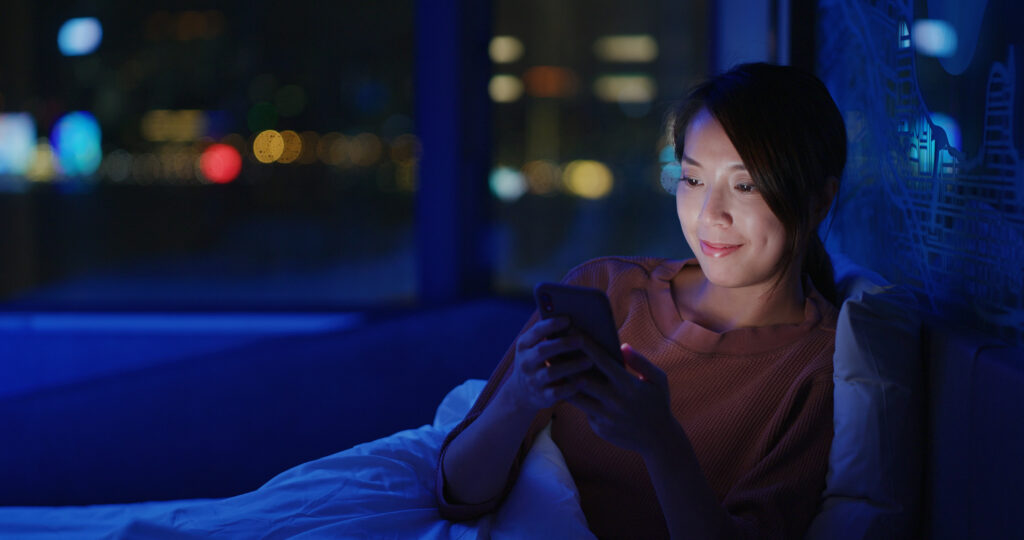
On April 25th, DXOMARK introduced a new display protocol. Our experts have streamlined the testing process from six to four essential attributes: readability, video, color, and touch.
This update also includes some exciting new features:
- new HDR video quality targets;
- updated color targets to reflect geographic color mode preferences;
- expanded test conditions to include use cases with brighter lighting.
In response to growing user concerns about the impact of screen time on health, particularly sleep, DXOMARK has been working diligently to provide a solution.
Discover the Eye Comfort Label, a major development from our team. This label is designed to evaluate the key factors that affect our visual experience and comfort, such as blue light filtering and flicker perception.
Let’s take a closer look at the details of this up-to-date label.
Growing awareness of vision health
There is widespread interest in the smartphone industry to address issues related to screen time, up-close reading, and maintaining optimal eye comfort. For example, in France, the average screen time in 2023 was 4 hours and 37 minutes, reaching up to 7 hours for teenagers.11 Source: franceinfo, Screen time in France
One major concern is blue light exposure, which has been shown to affect sleep quality, overall well-being, and even athletic performance.22 Source: NCBI, The effects of blue light This is in part because blue light (within a specific wavelength range) inhibits the production of melatonin, the hormone responsible for sleep.
In addition to blue light, other factors like flicker and luminance levels can potentially affect vision and overall well-being.
Screens are not harmless, but in relatively rare and severe cases, they can cause epileptic seizures. Flashing lights or certain visual patterns can trigger seizures in 3% of people with epilepsy,33 Source: Photosensitivity and Seizures | Epilepsy Foundation a condition known as photosensitive epilepsy.
The issue of eye comfort has gained significant attention in recent years, attracting both media and public interest. According to Meltwater, mentions of the topic in media and social media increased by 26.9% from 2022 to 2023.
China is grappling with a major public health issue related to smartphone addiction, particularly among college students. It also has high rates of cell phone addiction among teenagers and young adults.44 Source: ScienceDirect, Smartphone addiction around the world
Data from a DXOMARK survey of 1,737 participants on Weibo, WeChat, Instagram, and X (Twitter) in February 2024 revealed that:
83% of the respondents are concerned about the impact of daily smartphone use on their sleep and vision;
43% consider eye comfort when buying a new smartphone;
71% already use eye comfort mode or night mode.
Solutions from the smartphone industry
Eye comfort and care have become a selling point in the smartphone industry. For example:
- Apple’s IOS 17 includes vision health features;
- Huawei’s eye comfort mode is designed to reduce eye strain by minimizing blue light;
- Honor promoting eye comfort with its latest flagship;
- Xiaomi has also recently published a white paper on eye care.
Also, most devices now include a night mode or blue light filter feature.
DXOMARK’s four major criteria

The Eye Comfort Label serves as a specific guide for users to enjoy their smartphones without neglecting potential impacts on visual comfort. The DXOMARK label is structured along four aspects that are recognized by scientific communities. To receive this label, devices need to pass four tests by meeting the thresholds set by engineering teams.
- Temporal light modulation
Temporal light modulation is a technique used by manufacturers to manage the luminance output of the screens. This modulation creates temporal light artifacts such as flicker and stroboscopic effects, all of which are unwanted visual effects.
The temporal light modulation criterion assesses flicker perception, which is the change in luminance perceived by the human eye, often characterized by quick oscillations of light output between on and off.
The Flicker Perception Metric is a recommended metric for assessing the direct perception of light source flicker.55 Source: Alliance for Solid-State Illumination Systems and Technologies (ASSIST), Flicker Metric The metric quantifies the amplitude and frequency of the modulation and compares it to human detection thresholds. A metric below 1 indicates that less than 50% of people will perceive the flicker. The DXOMARK experts have adopted this value as a basis for evaluation. If the Flicker Perception Metric is <1 (in anti-flicker mode or default mode), the device passes the evaluation.
What is flicker?
Flicker relates to Temporal Light Modulation inferior to 90 Hz and can be perceived depending on frequency and individual’s sensitivity.
The physiological response of flicker includes:
- dilation and constriction of the iris in response to changes in brightness;
- an involuntary reaction that can lead to headaches and eye fatigue, especially after prolonged exposure to flickering displays.
The effects of flicker are more noticeable in low-light conditions, such as reading in bed with the lights off. In such settings, the strain on the eyes is increased, contributing to increased discomfort and fatigue.
2. Brightness level
Most smartphones have an automatic brightness feature that adjusts to your environment. Also known as auto-brightness or adaptive brightness, this feature is designed to enhance the user’s viewing experience by dynamically adjusting the screen brightness based on the ambient light level.
The purpose of this evaluation criterion is to ensure that the automatic brightness mode prevents screen glare in low-light conditions while still providing sufficient brightness for visibility.
Based on extensive experience, user feedback, and a database of thousands of device tests, our experts have determined that the auto-brightness feature should provide a minimum luminance level of 2 nits to ensure a comfortable experience for the most sensitive users.
3. Blue light filtering
Of all the different types of light, blue light has the most significant effect on melatonin inhibition. This concept is further explored in a scientific paper published in 2015, “Analyses of circadian properties and healthy levels of blue light from smartphones at night.”66 Source: NCBI
Blue light filtering is an important consideration when evaluating the impact of smartphones on sleep hormones at night. One way to measure this is to use the circadian action factor (CAF).
This ratio evaluates the effect of different types of light on sleep cycles by looking at how they inhibit melatonin, the hormone associated with sleep.
The CAF, as proposed in the paper, is a metric that measures the efficiency of filtering blue light without negatively affecting visual efficiency. It is calculated as the ratio of circadian efficiency to visual efficiency.
At DXOMARK, we use a maximum CAF of 0.65.
An average CAF of 0.65 is comparable to that of a regular white LED light source, which is commonly used.
The human eye has specific sensitivity functions that affect both vision and sleep. In the graph below77 J. H. Oh, H. Yoo, H. K. Park, and Y. R. Do, “Analysis of circadian properties and healthy levels of blue light from smartphones at night,” Scientific Reports, vol. 5, no. 1. Springer Science and Business Media LLC, Jun. 18, 2015. doi: 10.1038/srep11325., the blue line shows the peak of circadian sensitivity, which occurs at a light wavelength around 450 nanometers (which corresponds to blue).On the other hand, the yellow line represents visual sensitivity. It’s worth mentioning that a low circadian factor indicates a minimal impact on sleep.
4. Color consistency
When looking at the impact of a blue filter mode on color performance, it is important to evaluate how the color display is affected. With a blue filter, the white point of the display becomes slightly more orange, and there is a reduction and shift in the color domain covered.
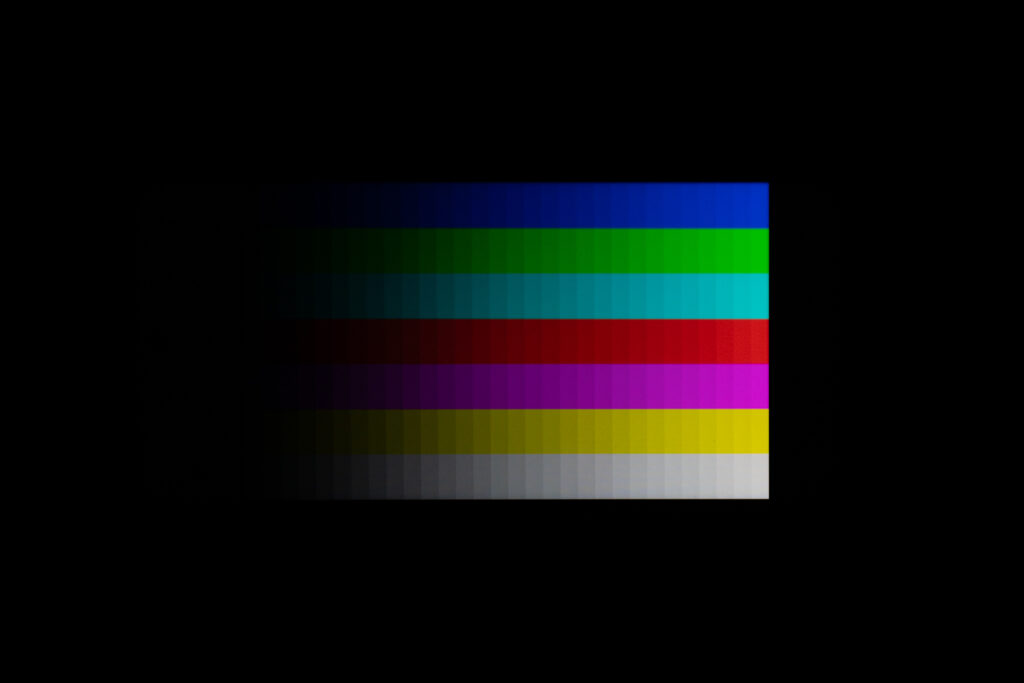
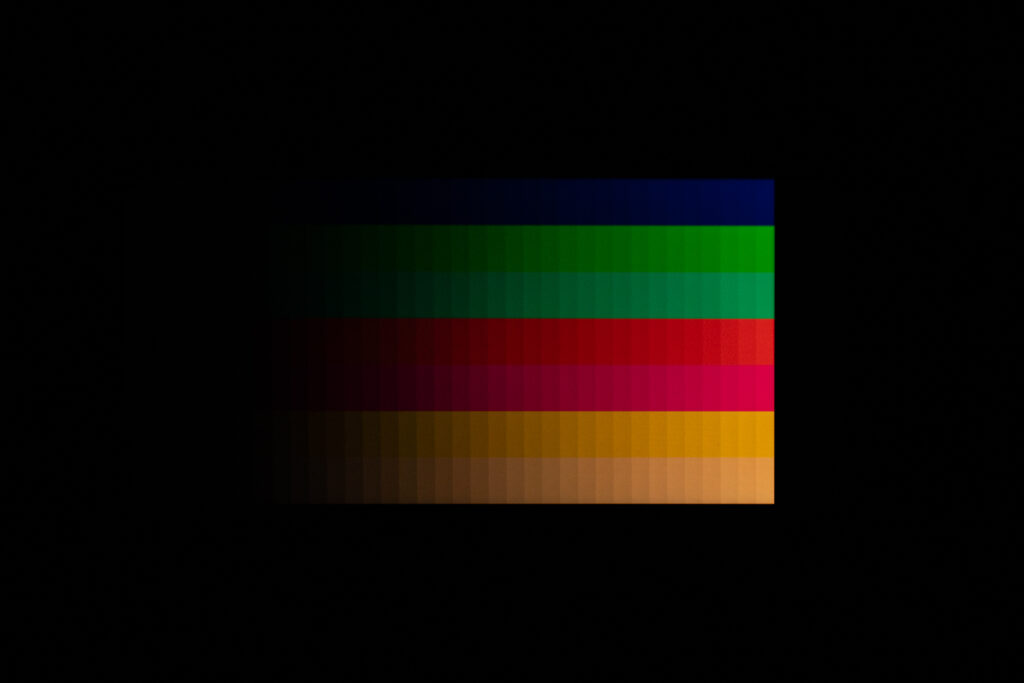
Ensuring consistent color nuances is a challenge, and this is exactly what we test by evaluating color consistency. We use the Display-P3 color gamut, which is widely used by manufacturers.
Typically, most smartphones today cover 100% of the Display-P3 color space without a blue filter mode. We believe that a blue light mode is beneficial as long as it does not degrade the overall user experience. At DXOMARK, we set a threshold of 95% or more coverage of the Display-P3. This minimum coverage of the Display-P3 ensures a certain level of comfort for smartphone users.
After all, what is the point of implementing a blue filter or night mode if consumers don’t use it because it negatively impacts their experience?
Where to find the label
Each tested product has a high-level product review on dxomark.com. Products that pass will display the label on the page.
On each test results page, you will find detailed information about each of the device’s results, including a breakdown of the eye comfort criteria.
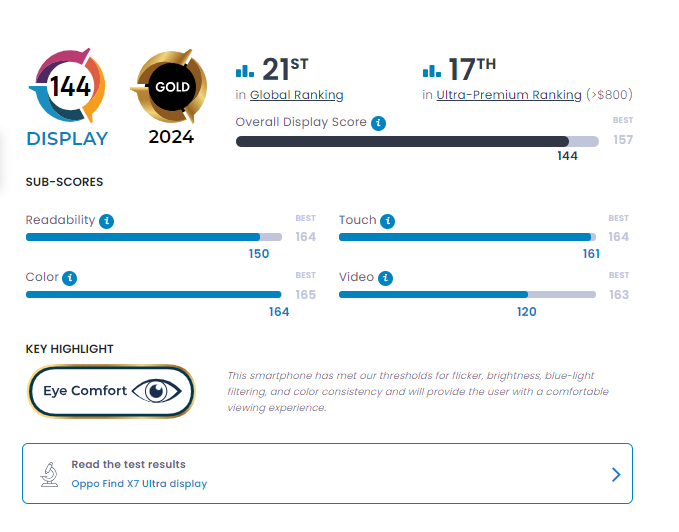
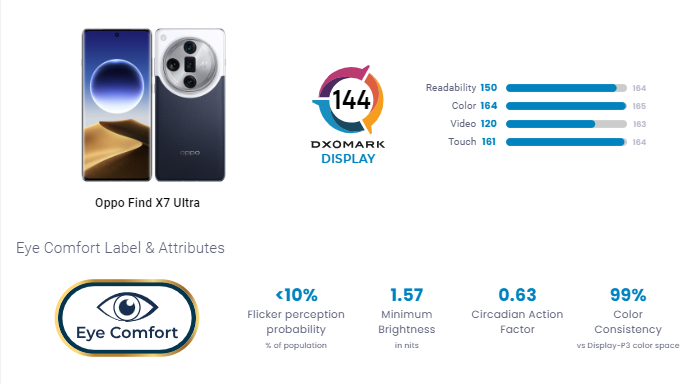
“This label is designed for users of all technical abilities. It helps consumers to choose the right device and incorporates key factors from industry and research. Our ratings are open to everyone and are continually updated with new research.”
Thibault Cabana,
Display Quality Evaluation Director at DXOMARK
What’s next in eye comfort?
DXOMARK experts are exploring to establish a metric for evaluating the Phantom Array Effect, a recognized temporal light artifact for which there is currently no standard.
The Phantom Array Effect is the perception of seeing repeated images of the light source when making a rapid eye movement (saccade) across a modulated source. Our teams are working with leading academics such as Professor Emeritus Arnold Wilkins, a renowned authority on vision research, to study and define a precise threshold for this phenomenon.
“Often overlooked, temporal light artifacts play a significant role in visual comfort and warrant thorough evaluation. DXOMARK is pioneering the introduction of innovative metrics to the smartphone industry.”
Arnold Wilkins,
Professor Emeritus at the University of Essex
We are entering a new era in vision care that promises to make screens more comfortable to use and easier on the eyes.


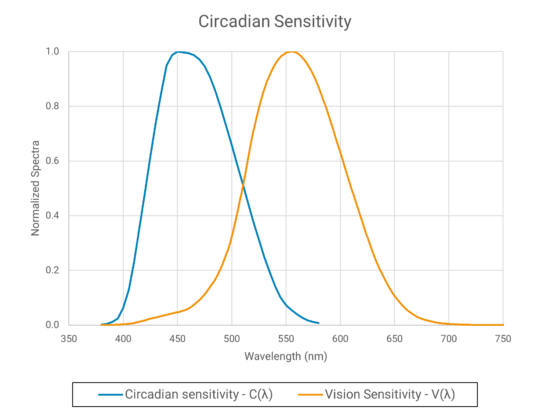
DXOMARK encourages its readers to share comments on the articles. To read or post comments, Disqus cookies are required. Change your Cookies Preferences and read more about our Comment Policy.